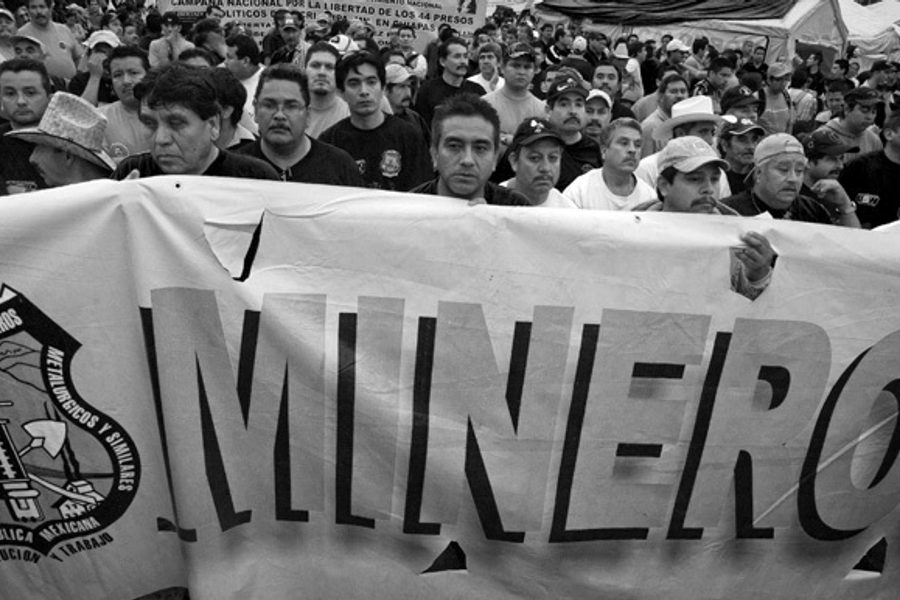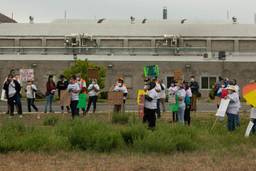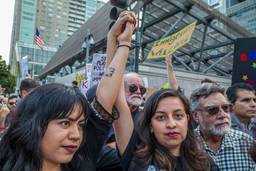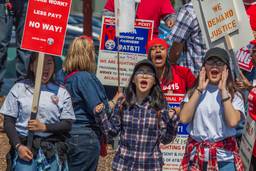
Jacinto Martinez is the labor secretary of Section 65 of the Mineros, Mexico’s union for miners and one of the oldest unions in the country. His union has been on strike for five years at the huge Cananea mine, one of the longest strikes in the history of North America. Critical support for this strike has come from the United Steelworkers, and both unions have announced their desire to merge to form a single organization.
Below, Martinez describes the history of the strike and the horrifying conditions in Cananea today. I interviewed him two weeks ago.
Our town is where the Mexican Revolution began in 1906, at a time when miners there were virtually enslaved. The mine was eventually taken over by the government, which ran it for many years. Nevertheless, over the last hundred years there were many strikes in this mine over wages and working conditions.
Finally, in 1989, the government stopped all operations at the mine, and President Carlos Salinas de Gortari declared that the mine was bankrupt. In August of that year the government sent in federal troops. The miners were expelled from the mine, and the mine was closed for three months. Then Salinas sold it to private owners, Grupo Mexico, the company run by the Larrea family. Really, it was basically given away. The government had just invested 400 million pesos in the ore concentrator alone. Grupo Mexico bought the whole mine for 650 million.
After the Larrea family took over, we’ve had nothing but battle after battle with them. They are one of the largest mining companies in the world, and one of the richest families in Mexico. The company was forced to make certain commitments in order to take over the mine, but they’ve never fulfilled any of them. One was to share with the workers five percent of the price they’d paid for the mine. Because of their failure, in 2004 we took action to force the company to pay what had become by that time a debt of 55 million pesos.
After that things became even more difficult. Before, the government was at least a little concerned for our welfare. Now all dialogue with the government has been cut off, and they give total support to Grupo Mexico.
We went on strike again on June 30, 2007, because of the deteriorating conditions in the mine. Once the strike started, the federal government, through the labor board, declared it illegal several times. Each time we’ve gone to court, and the courts have overruled the board and restored the strike’s legal status. According to the InterAmerican Commission on Human Rights, we have a right to return to our jobs.
Once again, on April 14, 2010, the strike was declared legal by the courts. Nevertheless, at 10 p.m. the same day the company withdrew recognition from our union and broke off its employer/union relationship with us. That was completely illegal. But the government then brought in police and troops, and allowed the company to reopen the mine.
At the time we went on strike, there were about 1,200 members of our union. Now there are still 850 people on strike, five years later. The company has tried to buy people off by offering them severance pay if they’ll give up any claim to their jobs. In my case, after 23 years working in the mine, they’ve offered me 1,007,000 pesos [about $85,000]. They’ve said that in addition, they’d give me 830,000 pesos to try to buy me out. But I won’t take their offer, nor will any of the strikers.
We don’t have Social Security medical insurance, so the medical care we get comes from the company as part of our employment. If we take their offer, we will lose all our medical care. The 850 strikers have been fighting for this too. To make matters worse, on Mother’s Day in 2008, the company gave us an additional gift by closing the hospital where we received our care. Counting children and retirees, an additional 1,200 people lost their medical care because of that.
The government stepped in to provide some services, but even though we can see a doctor again, we have no money to buy medicine. This has hurt our retirees especially, because now they have to pay for medicine, where in the past the company had to provide it. Some of us have severe problems because of working in the mine, like silicosis and high blood pressure, so doing without medical care is not an option.
To protest government support for the company, about 50 miners have gone to Hermosillo, the state capitol, where they are occupying a site near the government building. When they come back to Cananea, other workers go to take their place. We are not the only local union of miners on strike. Section 17 has been on strike in Taxco and Section 201 in Zacatecas. We are all facing Grupo Mexico.
We are also protesting over what happened at Pasta de Conchos in 2006. The union made many requests to the Labor Secretary, asking that the government conduct inspections of that mine. But there were none, and finally there was a terrible explosion in which 65 miners were trapped inside and died. The only thing they did was close the mine. The company even refused to go in and bring back the bodies, and the government backed them up. The company and government claimed it was an accident. But the president of our union, Napoleon Gomez Urrutia, held a press conference and called it industrial homicide. After that, the government tried to arrest him and he had to flee to Canada.
Since we’ve been fighting Grupo Mexico, we’ve had the financial support of the United Steelworkers in the U.S., who also gave sanctuary to our president. [Editor’s note: See this recent In These Times story about exiled Mineros leader Napoleon Gomez Urrutia’s successful fight against government corruption charges.] That’s how we’ve been able to survive. More than 80,000 workers are contributing to our ability to go on fighting. And we are also receiving contributions from our own members in Mexico who are still working. So our situation in Cananea isn’t good, but we’ve been able to continue for five years. Our members still support the strike totally.
The company has been able to restart production, using about 3,000 workers who are employed by contractors. There are about 2,000 federal soldiers guarding them. They’ve turned Cananea into an armed camp. They have towers with machine guns watching over people, and you can’t even pass through certain streets in the center of town. This is why we’re supporting Andres Manuel Lopez Obrador in his campaign for president in our national elections in July. He’s promised that if he’s elected, he’ll defend us.
Grupo Mexico is really destroying Cananea. The mine pumps water from about 70 wells. Cananea, with a population of 30,000, only has two or three. The mine is buying up land throughout this area, and now has more land than the town itself. They use it to dump the mine tailings, which have already buried part of the old town.
Meanwhile, of the 300 members of our union who betrayed us and went back to work, only about 50 are left. The only way they’ve been able to make the mine run is by bringing in 3,000 people from outside, from Oaxaca, Puebla and other states in the south. The economic situation in these states is worse than here in the north. There’s no work, no jobs there.
Grupo Mexico has built special housing for many of the strikebreakers on the mine property, called colectivos. They’re like barracks. For others, the company rents big houses in town, where a lot of them are housed together. The company then picks them up in busses in the morning and brings them back at night. That way it controls them. And the whole economy of Cananea has collapsed because these workers aren’t living in the area like normal residents. Many of them actually come here because we’re close to the U.S. border, and they’re thinking about jumping the fence. The reality is that the economy here is pretty dead.
Grupo Mexico mistreats these workers. It’s gone back to the same conditions people rose up against in 1906, when miners went on strike for the 8-hour day. The strikebreakers are working 12 hours a day. They all have to belong to a protection union, part of the CTM [the Confederation of Mexican Workers, affiliated to Mexico’s former ruling party, the PRI]. Then, after working four or five months, the company fires them. They only get 1,300 pesos a week [about $100], so when people want to go home, they don’t have enough money to get back. Some of the fired workers wander through the streets, begging for help from other workers so they can get home.
With people brought in from outside to work the mine, the only solution for the people of Cananea itself is to leave, to migrate. There’s no other work here. Some go to other states, or to other cities in northern Mexico. They leave by themselves to look for work. Then right after they get paid on Friday, they send the money home to their families. Most go to the United States.
That’s logical, because the border is only a half hour away, and Tucson’s only three hours from here. And that’s where the work is. Sometimes people just go to work for two or three weeks, and then come back, trying to find a way to keep on living here. They try to use the work in the U.S. to build up their reserves. This also happened after the three-month strike in 1998.
The people who are on strike are all people who live here, and most of us have been living here for generations. The head of our strike committee, Jesus Verdugo, is the third generation in his family to work in the mine. Now his children are old enough to work. But if we don’t win the strike, they’ll never work here. We’re losing our traditions; we’re losing the whole history of Cananea. And this is because of what Grupo Mexico and the federal government are doing to us.
You could say we’re fighting for our right and ability to keep on living in Cananea.
David Bacon is a writer, photographer and former union organizer. He is the author of The Right to Stay Home: How US Policy Drives Mexican Migration (2013), Illegal People: How Globalization Creates Migration and Criminalizes Immigrants (2008), Communities Without Borders (2006), and The Children of NAFTA: Labor Wars on the US/Mexico Border (2004). His website is at dbacon.igc.org.







